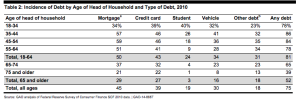More than 700,000 U.S. households headed by people 65 and older are living with student debt. According to a 2014 report from the Government Accountability Office, these older Americans still owe more than $18 billion in student loans. About 27 percent of these loans are in default for people between 65 and 74 and more than half of these loans are in default for people 75 and over. All in, about three percent of households headed by someone over 65 holds student debt.
The federal government can seize up to 15 percent of the Social Security check of retirees in default to pay back student loans. Since most older adults rely on Social Security benefits for half or more of their income, that’s a hefty chunk of money. And, often the lowest paid workers claim Social Security benefits at 62, reducing their benefits by 25 percent. Many policymakers now agree that we need to expand Social Security benefits and former Labor Secretary Robert Reich has a short video explaining why we can afford to do so.
The government has the right to go after student loans that are in default while you are working, but that requires the government to sue and get a court order. It’s far easier for the government to seize Social Security benefits directly. Under the law, the government can either attach funds or seize Social Security funds that have been in the bank for more than two months.
Of note, the number of Americans 50 and older with student loan debt has grown significantly in the 21st century, from 3 million in 2005 to 6.9 million in 2012. Benefits were offset for about 36,000 retirees over 65 in 2013, six times as many as in 2002. And the amount of debt grew more than six-fold between 2005 and 2013, to $18.2 billion. More than 80 percent of the debt was for people’s own education, and about 18 percent for a child or grandchild.
If you’re not sure whether you still owe money on a student loan, call the U.S. Department of the Treasury’s Bureau of the Fiscal Service (800 304-3107) If you owe money, you might want to contact your local legal aid office to see if staff can help you work out a viable loan repayment plan. And, if you want to learn what your Social Security benefits will be when you retire, click here.












I have had more than 15 percent of my SS check taken for a student loan. Presently they take $115 out of a $865 check. I called SS and Dept of Education but got no answers. They both referred my to their website. I sent a letter to the White House and got the same reply. The main problem, above reducing my income, is that the Dept of Education adds an interest to my loan every month so even when I make a payment, it does not reduce my loan. It is like I am giving them money because no matter what I give them, my loan does not change, in fact it just gets bigger. No government will answer my questions, so I am stuck. Is this a way for the government to get back all the SS money I am getting? Have they found a way because they can’t stop SS so they take it back in small chunks? It makes me think that the government wants us “old folks” to be homeless or go away and die.
Are you eligible for the IBR (income based repayment) programs yet?
I am now on the 25 year one, that recalculates my proposed payt every 12 months, depending upon my Adjusted Gross Income from my tax returns… & then compares that figure to the 150%? of Federal Poverty Level.
So far, my payes are = $0, “deferred status”.
If I reach the age of 90 yrs (25 yrs on the IBR), then the rest will be forgiven…
I call it a “race with the tombstones”!!